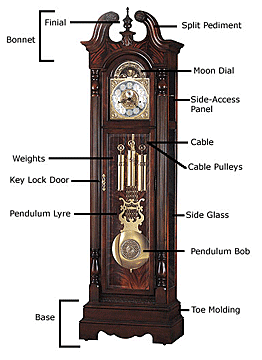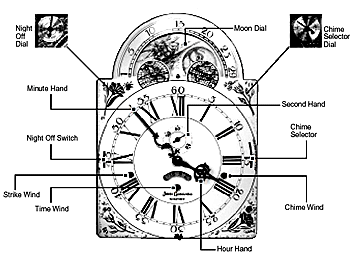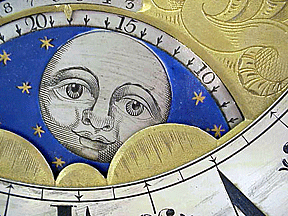 Tall
case clocks first appeared when noted astronomer and physicist
Christian Huygens developed a pendulum-style floor clock in 1656.
Employing a pendulum in clocks revolutionized clockmaking and
brought to timekeeping a more accurate method of timekeeping than
any other timepiece of its day. By 1660, London clockmakers had
perfected Huygen’s invention and began making long-case clocks,
or Grandfather Clocks as they’re known today, standing in a
six-foot-tall wooden case with an enclosed pendulum and weights
suspended by chains or cables, which needed to be adjusted
periodically to keep the proper time. Grandfather clocks are very
accurate and can keep time to within one minute per month.
Tall
case clocks first appeared when noted astronomer and physicist
Christian Huygens developed a pendulum-style floor clock in 1656.
Employing a pendulum in clocks revolutionized clockmaking and
brought to timekeeping a more accurate method of timekeeping than
any other timepiece of its day. By 1660, London clockmakers had
perfected Huygen’s invention and began making long-case clocks,
or Grandfather Clocks as they’re known today, standing in a
six-foot-tall wooden case with an enclosed pendulum and weights
suspended by chains or cables, which needed to be adjusted
periodically to keep the proper time. Grandfather clocks are very
accurate and can keep time to within one minute per month.
But it was the invention of the anchor escapement in 1671 by
English clockmaker William Clement, using a "seconds"
pendulum, 39 inches long and vibrating through a small arc, that
helped make the tall case clock practical. This invention plus
another, the dead beat escapement, invented by George Graham in
1715, plus the elongation of the pendulum for greater accuracy, an
enhanced case and added chimes that made the Grandfather Clock
what it is today.
 While
the most popular model was the larger Grandfather clock, a smaller
and less-expensive version, known as the Grandmother clock, was
also available. These clocks often had 12-hour faces with a sweep
second hand. Only one of
the winding holes, the one on the right, was functional. The other
nonfunctional one presented a point of balance.
While
the most popular model was the larger Grandfather clock, a smaller
and less-expensive version, known as the Grandmother clock, was
also available. These clocks often had 12-hour faces with a sweep
second hand. Only one of
the winding holes, the one on the right, was functional. The other
nonfunctional one presented a point of balance.
Seventeenth-century clockmakers decided that the beginning and
end of a week was a time that people wouldn’t likely forget.
But, just in case, they added one day for good measure–thus, the
8-day clock. They made sure there was enough room in the tall case
to permit the weight a full drop for that length of time without
complicating matters with additional wheels. A polished disc
called a bob, attached to the lower end of the pendulum or
suspended by cables from a fixed support that swings freely back
and forth under the influence of gravity, operates the clock and
ensures accurate time.
 Heavy
lead weights, that had to be wound up daily by pulling on a chain
or using a winding crank, provided the power to move the cogs and
wheels of this type of clock. Clockmakers encased the movement in
a wooden cabinet, originally made by coffinmakers, with a dial
that told the time. Many of the dials track the phases of the moon
through the 29 1/2 days of the lunar month. As the rotating moon
dial passes behind the Eastern and Western Hemispheres, the phases
of the moon–new moon, waning crescent, half moon, and full moon–appear
at appropriate times during the cycle. The dials also displayed
the month and sometimes the day or the week. Sweep-second hands
weren’t common on earlier Grandfather Clocks.
Heavy
lead weights, that had to be wound up daily by pulling on a chain
or using a winding crank, provided the power to move the cogs and
wheels of this type of clock. Clockmakers encased the movement in
a wooden cabinet, originally made by coffinmakers, with a dial
that told the time. Many of the dials track the phases of the moon
through the 29 1/2 days of the lunar month. As the rotating moon
dial passes behind the Eastern and Western Hemispheres, the phases
of the moon–new moon, waning crescent, half moon, and full moon–appear
at appropriate times during the cycle. The dials also displayed
the month and sometimes the day or the week. Sweep-second hands
weren’t common on earlier Grandfather Clocks.
The number of key holes in the dial of a Grandfather clock
indicate the clock’s type of movement. One winding hole
indicates that there’s only a time train. A second one indicates
a strike train, and a third allows for winding a chime. Today’s
Grandfather clocks have either 30-hour or 8-day movements.
The crown is generally referred to as being the top portion of
the grandfather clock. The most common crown styles are the split
pediment and the bonnet, which has a full arched facade. Other
common styles are arched, flat top and federal crowns.
A decorative ornament, called a finial, usually in wood or
brass, appears on top of the clock cabinet between split pediment
crowns on grandfather clocks. Access doors or panel inserts, on
the upper sides of clocks, allow access to the movement.
Today’s Grandfather Clocks come with one of four styles of
chimes:
